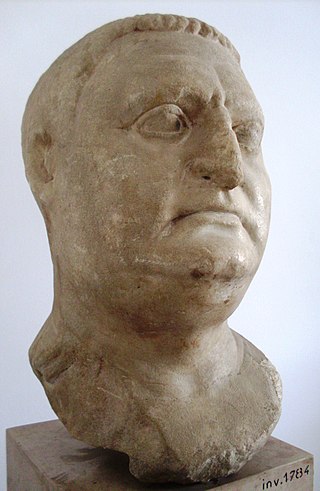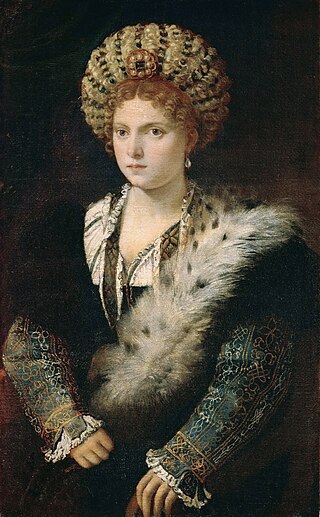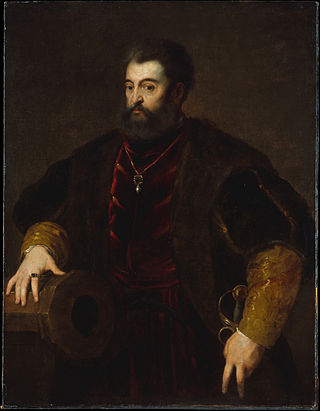
Aulus Vitellius was Roman emperor for eight months, from 19 April to 20 December AD 69. Vitellius was proclaimed emperor following the quick succession of the previous emperors Galba and Otho, in a year of civil war known as the Year of the Four Emperors. Vitellius was the first to add the honorific cognomen Germanicus to his name instead of Caesar upon his accession. Like his predecessor, Otho, Vitellius attempted to rally public support to his cause by honoring and imitating Nero who remained popular in the empire.

Titus Caesar Vespasianus was Roman emperor from 79 to 81. A member of the Flavian dynasty, Titus succeeded his father Vespasian upon his death.

Tiziano Vecelli or Vecellio ,, Latinized as Titianus, hence known in English as Titian, was an Italian (Venetian) Renaissance painter of Lombard origin, considered the most important member of the 16th-century Venetian school. He was born in Pieve di Cadore, near Belluno. During his lifetime he was often called da Cadore, 'from Cadore', taken from his native region.

Pietro Aretino was an Italian author, playwright, poet, satirist and blackmailer, who wielded influence on contemporary art and politics. He was one of the most influential writers of his time and an outspoken critic of the powerful. Owing to his communications and sympathies with religious reformers, he is considered to have been a Nicodemite Protestant.

De vita Caesarum, commonly known as The Twelve Caesars, is a set of twelve biographies of Julius Caesar and the first 11 emperors of the Roman Empire written by Gaius Suetonius Tranquillus. The group are: Julius Caesar, Augustus, Tiberius, Caligula, Claudius, Nero, Galba, Otho, Vitellius, Vespasian, Titus, Domitian.

Bernadino Campi was a Renaissance painter from Cremona, who worked in Reggio Emilia. He is known as one of the teachers of Sofonisba Anguissola and of Giovanni Battista Trotti. In Cremona, his extended family owned the main artistic studios. Giulio Campi and Antonio Campi, half-brothers, were distant relatives of Bernardino; the latter is generally considered the most talented of the family. All were active and prominent painters locally. Influences on Bernardino include local Cremonese such as Camillo Boccaccino and artists from neighbouring regions such as Correggio, Parmigianino and Giulio Romano. He made a number of sets of copies of the Eleven Caesars by Titian, then in the Gonzaga collection, adding one of Domitian, which he based on a work by Giulio Romano. Titian's originals were all lost in an 18th-century fire in Madrid.

Domenico Campagnola was an Italian painter and printmaker in engraving and woodcut of the Venetian Renaissance, but whose most influential works were his drawings of landscapes.

The Royal Alcázar of Madrid was a fortress located at the site of today's Royal Palace of Madrid, Madrid, Spain. The structure was originally built in the second half of the ninth century by the Muslims, then extended and enlarged over the centuries, particularly after 1560. It was at this time that the fortress was converted into a royal palace, and Madrid became the capital of the Spanish Empire. Despite being a palace, the great building kept its original Arabic title of Alcázar.

Aegidius Sadeler or Aegidius Sadeler II (1570–1629) was a Flemish engraver who was principally active at the Prague court of Rudolf II, Holy Roman Emperor and his successors.

Isabella in Black is a portrait of a young woman by Titian. It can be dated to the 1530s and is in the Kunsthistorisches Museum in Vienna. The artist and the date are undisputed. Beyond the museum documentation, there are repeated doubts about the person depicted.

The Portrait of Alfonso I d'Este is a now-lost painting by Titian, dating to 1523. It was painted as a pendant to the Portrait of Laura Dianti of the same year and is now known through copies, one of which is by Rubens and another of which is held at the Metropolitan Museum of Art in New York. Others are held in the collections of the countess of Vogüe Commarin at Dijon and the Statens Museum for Kunst in Copenhagen - the latter is the oldest but only shows the head and shoulders.

The Portrait of Isabella of Portugal is an oil-on-canvas portrait of Isabella of Portugal, Holy Roman Empress by Titian dating to 1548. It was part of the Spanish royal collection and is now in the Museo del Prado in Madrid.

La Bella is a portrait of a woman by Titian in the Palazzo Pitti in Florence. The painting shows the subject with the ideal proportions for Renaissance women. In parallel the stringent composition corresponds to Titian's real portraits. The work can be dated by a letter about "that portrait of that woman in a blue dress" in May 1536.

Portrait of Federico II Gonzaga is a painting by Titian, who signed it Ticianus f.. Today in the Museo del Prado, Madrid, it portrays Federico II, Duke of Mantua who married in 1529; the portrait may have been commissioned for the occasion. The dog, a Maltese, is a symbol of faithfulness.

The Madonna of the Cherries is a 1515 painting by Titian, heavily influenced by the work of Giovanni Bellini. Originally oil on wood, it was later transferred to canvas. During the 17th century it formed part of the collection of Archduke Leopold Wilhelm, where it was copied by David Teniers. It is now in the Kunsthistorisches Museum in Vienna.

Daniel Nijs (1572-1647) was a Flemish art dealer.

The Aldobrandini Tazze are a set of 12 silver-gilt standing cups in the shallow tazza shape, sometimes described as bowls or dishes. They are outstanding examples of Renaissance metalwork, described by John Hayward as "the most impressive single monument of Italian and perhaps European goldsmith's work of the 16th century", and by the Victoria and Albert Museum as "one of the most spectacular groups of 16th century silver to survive".

Ixion is a 1632 oil painting, signed and dated by Jusepe de Ribera. It shows a scene from Classical mythology, of Ixion being tortured as the eternal punishment meted out by Zeus. It is one of a series of four paintings by Ribera of the four "Furies" or "Condemned" from Greek mythology. It is held by the Museo del Prado in Madrid, along with Ribera's painting of Tityos; the other two, of Sisyphus and Tantalus, are lost.

Portrait of Charles V or Portrait of a Man Wearing the Order of the Golden Fleece is a c. 1549 oil on canvas painting by Titian, now in the Museo di Capodimonte in Naples.












































